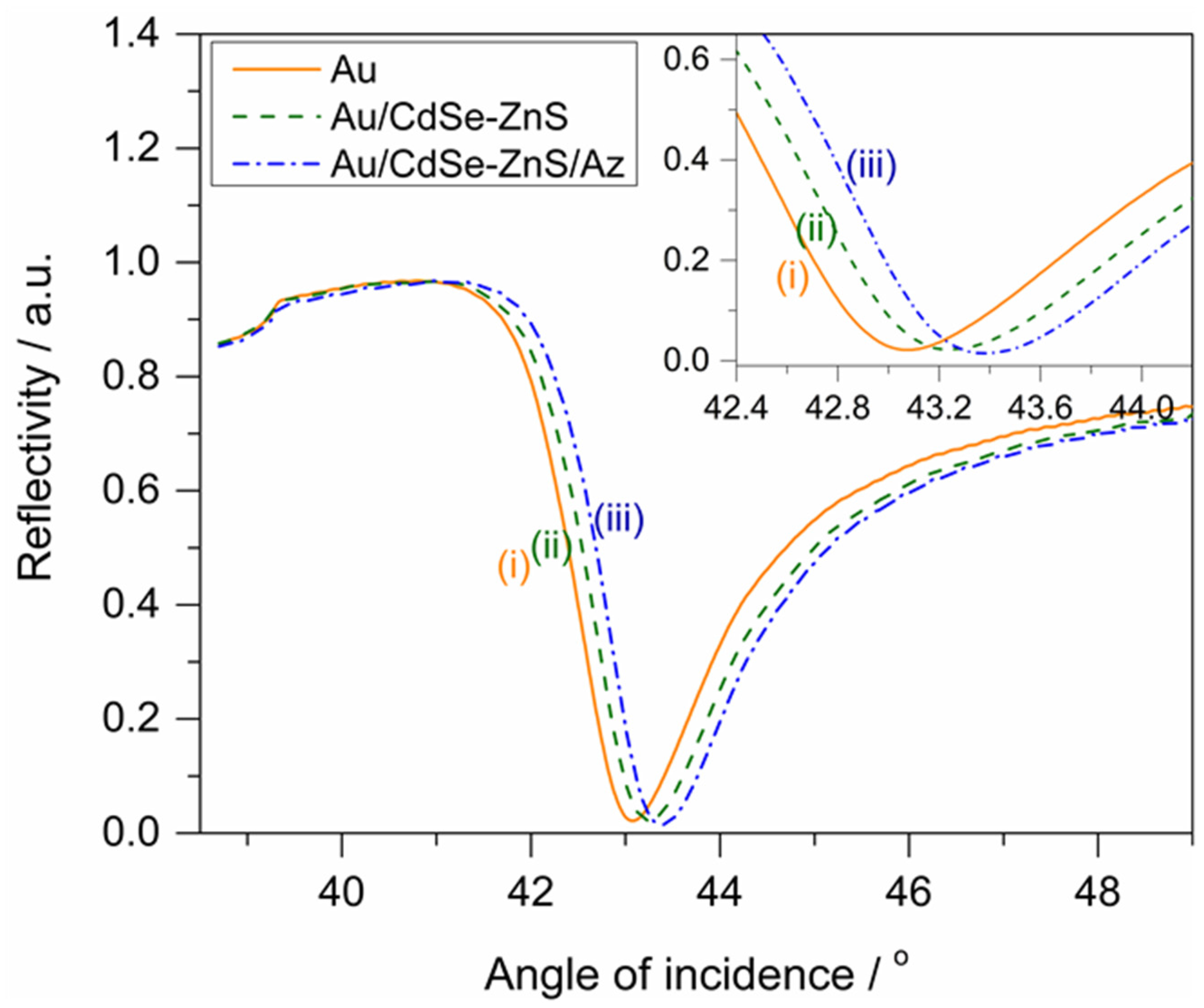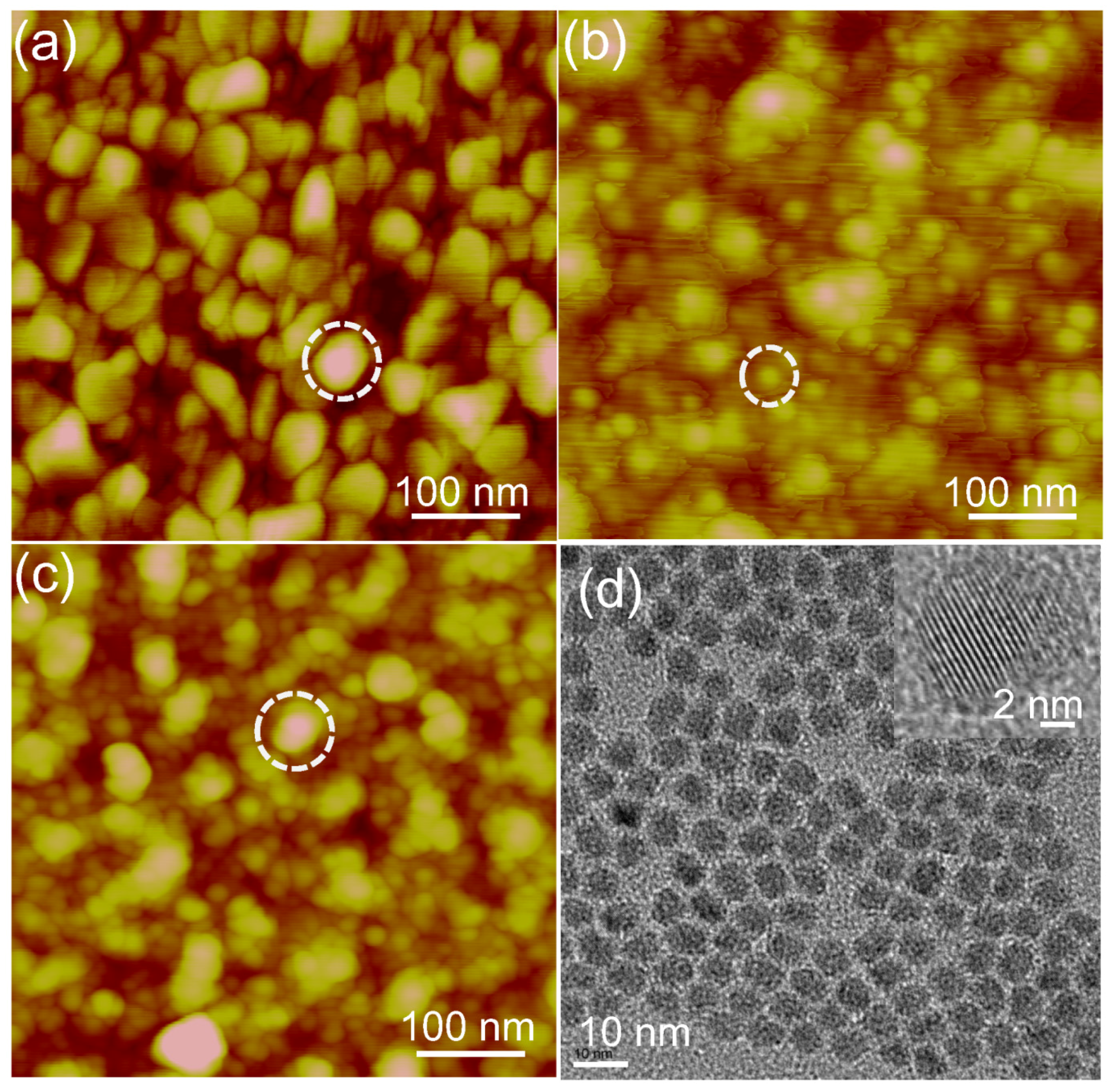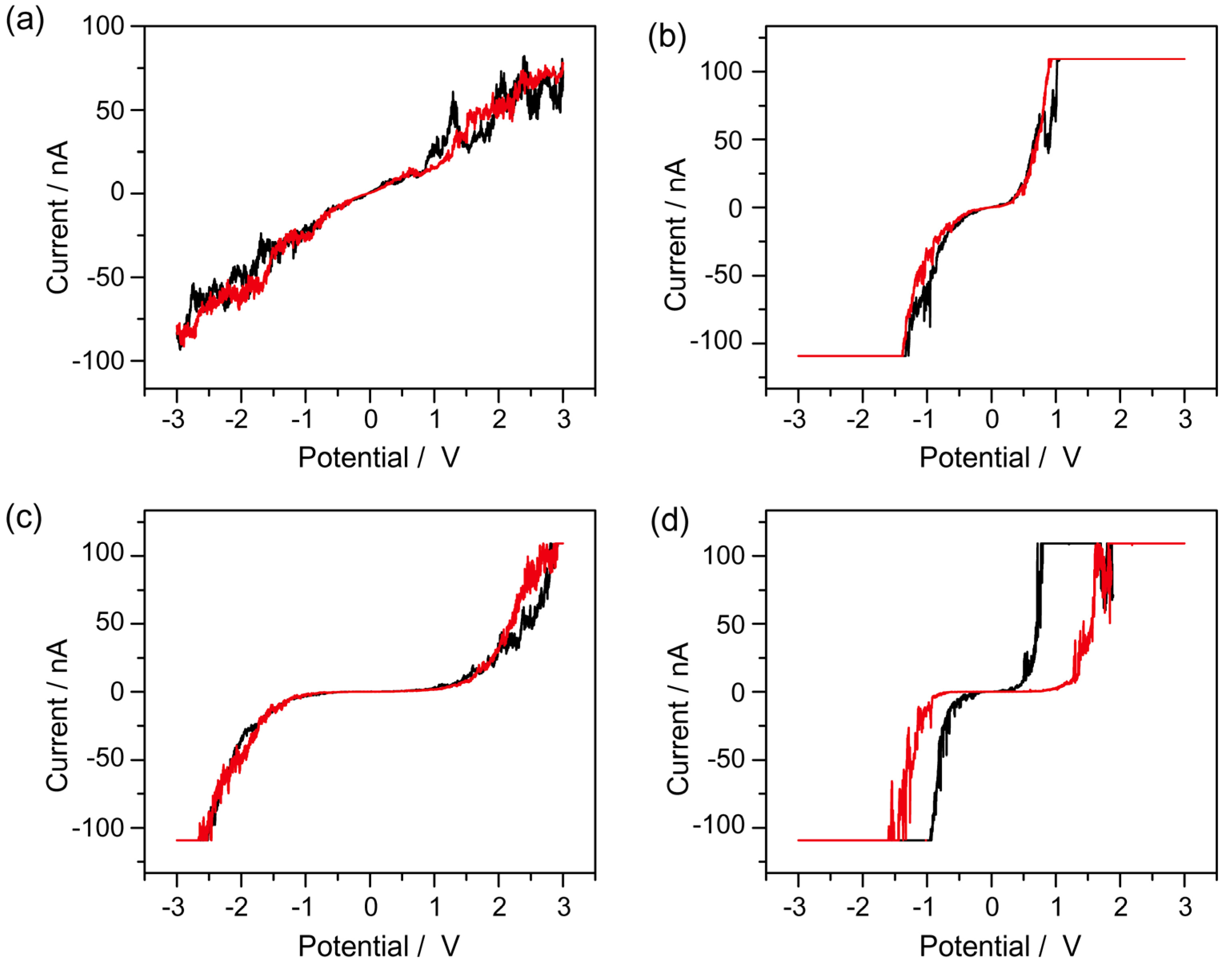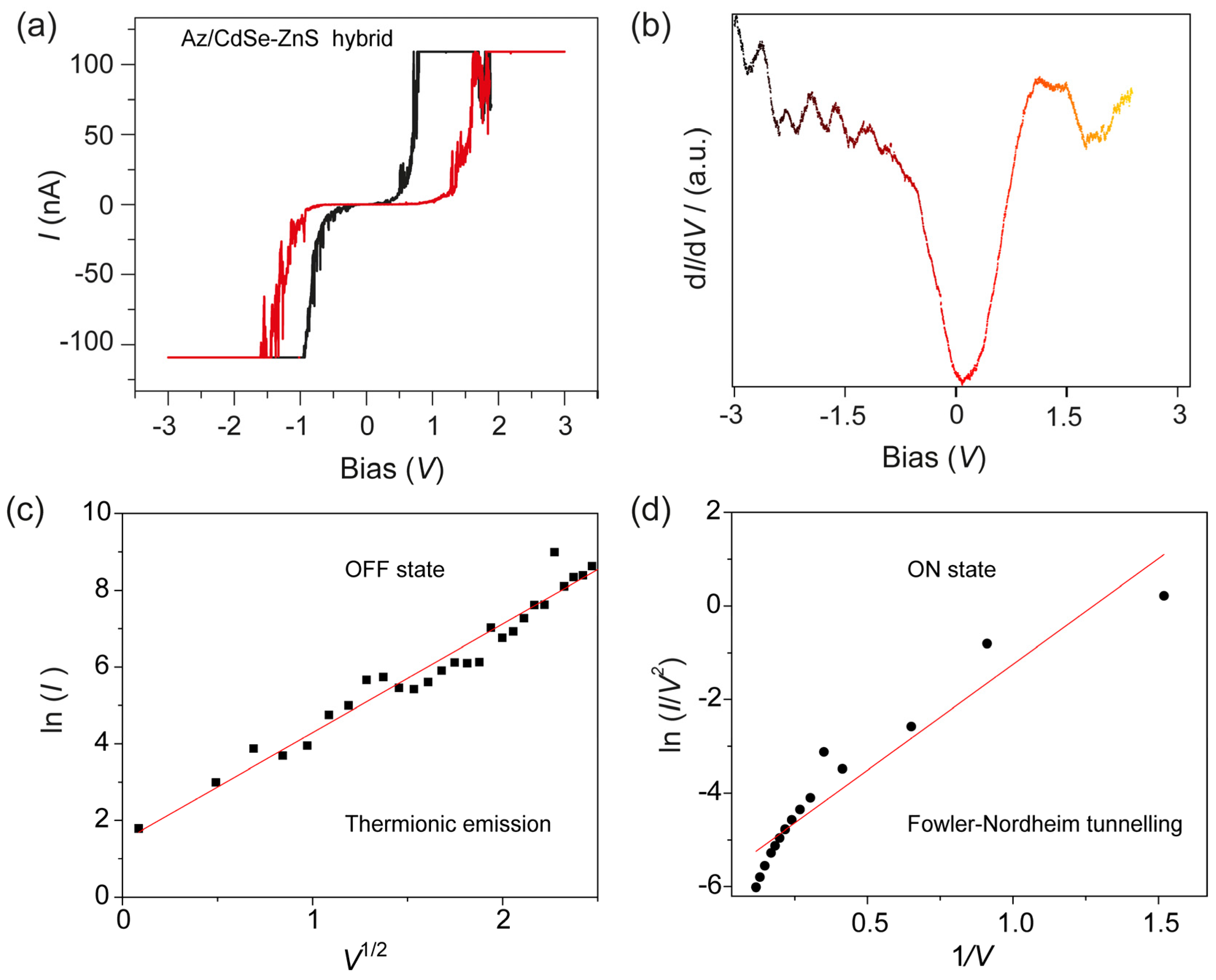Azurin/CdSe-ZnS-Based Bio-Nano Hybrid Structure for Nanoscale Resistive Memory Device
Abstract
:1. Introduction
2. Results and Discussion
2.1. Optical Characterization of Azurin and CdSe-ZnS Hybrids
2.2. Electrical Properties of Azurin, CdSe-ZnS and Azurin/CdSe-ZnS on an Au Electrode
2.3. Experimental Fit for ON-OFF Currents of Azurin/CdSe-ZnS Hybrid Layer on an Au Electrode
2.4. Robustness of the azurin/CdSe-ZnS Hybrid Device
3. Materials and Methods
3.1. Materials
3.2. Formations of Azurin/CdSe-ZnS/Au Hybrid Structures
3.3. Electrode Characterization of Azurin/CdSe-ZnS/Au Hybrids
4. Conclusions
Author Contributions
Conflicts of Interest
References
- Vargo, M.L.; Gulka, C.P.; Gerig, J.K.; Manieri, C.M.; Dattelbaum, J.D.; Marks, C.B.; Lawrence, N.T.; Trawick, M.L.; Leopold, M.C. Distance dependence of electron transfer kinetics for azurin protein adsorbed to monolayer protected nanoparticle film assemblies. Langmuir 2010, 26, 560–569. [Google Scholar] [CrossRef] [PubMed]
- Doan, T.T.; Vargo, M.L.; John, K.G.A.; Gulka, C.P.; Trawick, M.L.; Dattelbaum, J.D.; Leopold, M.C. Electrochemical analysis of azurin thermodynamic and adsorption properties at monolayer-protected cluster film assemblies–Evidence for a more homogeneous adsorption interface. J. Colloid Interface Sci. 2010, 352, 50–58. [Google Scholar] [CrossRef] [PubMed]
- Yagati, A.K.; Lee, T.; Min, J.; Choi, J.W. A robust nanoscale biomemory device composed of recombinant azurin on hexagonally packed Au-nano array. Biosens. Bioelectron. 2013, 40, 283–290. [Google Scholar] [CrossRef] [PubMed]
- Jensen, P.S.; Chi, Q.J.; Zhang, J.D.; Ulstrup, J. Long-range interfacial electrochemical electron transfer of pseudomonas aeruginosa azurin-gold nanoparticle hybrid systems. J. Phys. Chem. C 2009, 113, 13993–14000. [Google Scholar] [CrossRef]
- Delfino, I.; Cannistraro, S. Optical investigation of the electron transfer protein azurin-gold nanoparticle system. Biophys. Chem. 2009, 139, 1–7. [Google Scholar] [CrossRef] [PubMed]
- Yagati, A.K.; Lee, T.; Min, J.; Choi, J.W. Electrochemical performance of gold nanoparticle-cytochrome c hybrid interface for H2O2 detection. Colloids Surf. B 2012, 92, 161–167. [Google Scholar] [CrossRef] [PubMed]
- Uddin, A.; Wong, H.S.; Teo, C.C. CdSe/ZnS Quantum dot size dependent carrier relaxation in hybrid organic/inorganic system. J. Nanosci. Nanotechnol. 2012, 12, 7853–7859. [Google Scholar] [CrossRef] [PubMed]
- Han, Y.D.; Lee, Y.B.; Park, S.; Jeon, S.; Epstein, A.J.; Kim, J.H.; Kim, J.; Lee, K.S.; Joo, J. Quantum dot and π-conjugated molecule hybrids: nanoscale luminescence and application to photoresponsive molecular electronics. NPG Asia Mater. 2014, 6, e103. [Google Scholar] [CrossRef]
- Abbasi, E.; Kafshdooz, T.; Bakhtiary, M.; Nikzamir, N.; Nikzamir, N.; Nikzamir, M.; Mohammadian, M.; Akbarzadeh, A. Biomedical and biological applications of quantum dots. Artif. Cell Nanomed. Biotechnol. 2016, 44, 885–891. [Google Scholar] [CrossRef] [PubMed]
- Raccosta, S.; Baldacchini, C.; Bizzarri, A.R.; Cannistraro, S. Conductive atomic force microscopy study of single molecule electron transport through the Azurin-gold nanoparticle system. Appl. Phys. Lett. 2013, 102, 203704. [Google Scholar] [CrossRef]
- Pompa, P.P.; Chiuri, R.; Manna, L.; Pellegrino, T.; del Mercato, L.L.; Parak, W.J.; Calabi, F.; Cingolani, R.; Rinaldi, R. Fluorescence resonance energy transfer induced by conjugation of metalloproteins to nanoparticles. Chem. Phys. Lett. 2006, 417, 351–357. [Google Scholar] [CrossRef]
- SalmanOgli, A. Nanobio applications of quantum dots in cancer: Imaging, sensing, and targeting. Cancer Nanotechnol. 2011, 2, 1–19. [Google Scholar] [CrossRef] [PubMed]
- Zora, A.; P. Triberis, G.; Simserides, C. Near-field optical properties of quantum dots, applications and perspectives. Recent Patent Nanotechnol. 2011, 5, 188–224. [Google Scholar] [CrossRef]
- Yang, H.Y.; Fu, Y.; Jang, M.S.; Li, Y.; Lee, J.H.; Chae, H.; Lee, D.S. Multifunctional polymer ligand interface CdZnSeS/ZnS quantum dot/Cy3-labeled protein pairs as sensitive FRET sensors. ACS Appl. Mater. Interfaces 2016, 8, 35021–35032. [Google Scholar] [CrossRef] [PubMed]
- Ballou, B. Quantum dot surfaces for use in vivo and in vitro. Curr. Top. Dev. Biol. 2005, 70, 103–120. [Google Scholar] [PubMed]
- Jamieson, T.; Bakhshi, R.; Petrova, D.; Pocock, R.; Imani, M.; Seifalian, A.M. Biological applications of quantum dots. Biomaterials 2007, 28, 4717–4732. [Google Scholar] [CrossRef] [PubMed]
- Lee, T.; Kim, S.U.; Min, J.; Choi, J.W. Multi-level Biomemory Device Consisting of Recombinant Azurin/ Cytochrome c. Adv. Mater. 2010, 22, 510–514. [Google Scholar] [CrossRef] [PubMed]
- Zelman-Femiak, M.; Wang, K.; Gromova, K.V.; Knaus, P.; Harms, G.S. Covalent quantum dot receptor linkage via the acyl carrier protein for single-molecule tracking, internalization, and trafficking studies. Biotechniques 2010, 49, 574–579. [Google Scholar] [CrossRef] [PubMed]
- Lingerfelt, B.M.; Mattoussi, H.; Goldman, E.R.; Mauro, J.M.; Anderson, G.P. Preparation of quantum dot-biotin conjugates and their use in immunochromatography assays. Anal. Chem. 2003, 75, 4043–4049. [Google Scholar] [CrossRef] [PubMed]
- Yagati, A.K.; Kim, S.U.; Lee, T.; Min, J.; Choi, J.W. Recombinant azurin-CdSe/ZnS hybrid structures for nanoscale resistive random access memory device. Biosens. Bioelectron. 2017, 90, 23–30. [Google Scholar] [CrossRef] [PubMed]
- Bandhopadhyay, A.; Pal, A.J. Large conductance switching and binary operation in organic devices: Role of functional groups. J. Phys. Chem. B 2003, 107, 2531–2536. [Google Scholar] [CrossRef]
- Donhauser, Z.J.; Mantooth, B.A.; Kelly, K.F.; Bumm, L.A.; Monnell, J.D.; Stapleton, J.J.; Price, D.W.; Rawlett, A.M.; Allara, D.L.; Tour, J.M.; et al. Conductance switching in single molecules through conformational changes. Science 2001, 292, 2303–2307. [Google Scholar] [CrossRef] [PubMed]
- Han, S.T.; Zhou, Y.; Wang, C.D.; He, L.F.; Zhang, W.J.; Roy, V.A.L. Layer-by-layer-assembled reduced graphene oxide/gold nanoparticle hybrid double-floating-gate structure for low-voltage flexible flash memory. Adv. Mater. 2013, 25, 872–877. [Google Scholar] [CrossRef] [PubMed]
- Lee, T.; Yagati, A.K.; Pi, F.M.; Sharma, A.; Choi, J.W.; Guo, P.X. Construction of RNA-quantum dot chimera for nanoscale resistive biomemory application. ACS Nano 2015, 9, 6675–6682. [Google Scholar] [CrossRef] [PubMed]
- Yagati, A.K.; Min, J.; Choi, J.W. Recombinant protein-based nanoscale biomemory devices. J. Nanosci. Nanotechnol. 2014, 14, 433–446. [Google Scholar] [CrossRef] [PubMed]
- Yagati, A.K.; Jung, M.; Kim, S.U.; Min, J.; Choi, J.W. Nanoscaled redox active protein adsorption on Au-dot arrays: An electrochemical scanning probe microscopic investigation for application in nano-biodevices. Thin Solid Films 2009, 518, 634–637. [Google Scholar] [CrossRef]
- Xu, L.P.; Chen, S.W. Scanning tunneling spectroscopy of gold nanoparticles: Influences of volatile organic vapors and particle core dimensions. Chem. Phys. Lett. 2009, 468, 222–226. [Google Scholar] [CrossRef]
- Chi, Q.J.; Zhang, J.D.; Andersen, J.E.T.; Ulstrup, J. Ordered assembly and controlled electron transfer of the blue copper protein azurin at gold (111) single-crystal substrates. J Phys. Chem. B 2001, 105, 4669–4679. [Google Scholar] [CrossRef]
- Chi, Q.J.; Zhang, J.D.; Nielsen, J.U.; Friis, E.P.; Chorkendorff, I.; Canters, G.W.; Andersen, J.E.T.; Ulstrup, J. Molecular monolayers and interfacial electron transfer of Pseudomonas aeruginosa azurin on Au(111). J. Am. Chem. Soc. 2000, 122, 4047–4055. [Google Scholar] [CrossRef]
- Fristrup, P.; Grubb, M.; Zhang, J.; Christensen, H.E.M.; Hansen, A.M.; Ulstrup, J. Voltammetry of native and recombinant Pseudomonas aeruginosa azurin on polycrystalline Au-and single-crystal Au(111)-surfaces modified by decanethiol monolayers. J. Electroanal. Chem. 2001, 511, 128–133. [Google Scholar] [CrossRef]





© 2017 by the authors. Licensee MDPI, Basel, Switzerland. This article is an open access article distributed under the terms and conditions of the Creative Commons Attribution (CC BY) license (http://creativecommons.org/licenses/by/4.0/).
Share and Cite
Yagati, A.K.; Lee, T.; Choi, J.-W. Azurin/CdSe-ZnS-Based Bio-Nano Hybrid Structure for Nanoscale Resistive Memory Device. Materials 2017, 10, 803. https://doi.org/10.3390/ma10070803
Yagati AK, Lee T, Choi J-W. Azurin/CdSe-ZnS-Based Bio-Nano Hybrid Structure for Nanoscale Resistive Memory Device. Materials. 2017; 10(7):803. https://doi.org/10.3390/ma10070803
Chicago/Turabian StyleYagati, Ajay Kumar, Taek Lee, and Jeong-Woo Choi. 2017. "Azurin/CdSe-ZnS-Based Bio-Nano Hybrid Structure for Nanoscale Resistive Memory Device" Materials 10, no. 7: 803. https://doi.org/10.3390/ma10070803





